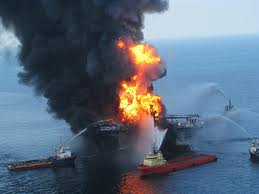
Using the “nightmare scenario” to catalyze change…
Since I started my career 22 years ago, I’ve always been intrigued by the use of the proverbial “burning platform” as a motivational tactic for catalyzing and effecting change within organizations. Originally, the “burning platform” was simply a metaphor used for a looming crisis that required a change in organizational thinking and behavior. More and more, however, these “burning platforms” are becoming more literal, making the consequence of “status quo” even more real and threatening to those who are on it.
There is no shortage of cases in which the threat of REALLY BIG negative consequences turned out to be an effective means of initiating major change within organizations, cultures, and individuals who were otherwise operating myopically, blind to many of the realities around them. We saw it in the 1960’s as MLK used present inequities among races, and what the future would look like if left unattended, to inspire what would become a successful civil rights movement that would change US and global principles, policies, legislation, and ultimately cultural behaviors themselves. Auto companies used the threat of overseas domination as a way to improve productivity and quality, and continue to use it as a way to sustain performance.
“Burning Platform” examples: Past and present…
We are also seeing it quite literally now, as nuclear companies have used past examples of Three Mile Island, Chernobyl, and now the as-yet-unresolved crisis at Fukushima, as a way to renew the industry’s focus on safety. And of course, all major oil companies are using the consequences of the BP spill of 2010 as a catalyst for driving major improvements in operational safety. The latter is a particularly good example, as on the day of the explosion itself, the company was celebrating a long string of days without a recordable safety event!
Late last year, Nokia’s new CEO Stephan Elop used the same tactic to catalyze the need for some dramatic new thinking within his organization. To amplify the importance of responding quickly to what appears to be a competitive nightmare scenario, he sent a memo to the organization comparing its circumstances to that of a “burning platform” surrounded by the “icy waters” of the North Sea. In this case, survival meant risking both a fall and survival of icy waters in order to avoid the certain death of being consumed by fire. Talk about a wake up call!!!

Even humanity in general uses the “burning platform” as a way to inspire vigilance and action around things like spirituality and lifestyle. Most are aware of Harold Camping’s prophesies around the projected May 21st “Rapture” of Christians worldwide and the October 21st end of the world as we know it (Sorry if that puts a damper on anyone’s springtime plans :), but hey, I’m just the messenger!). Regardless of your religious background, or whether you “buy into” this or the myriad of other “end of days” proclamations, prophesies like this one certainly get our attention, and remind us of the importance of staying in close touch with our maker–lest we risk the ultimate in “burning platforms.”
Nevertheless, most of the successful uses of the “burning platform” tactic of motivation, particularly those in business, are based in fear–fear of losing customers, fear of losing market share, fear of financial collapse, and the myriad of other risks associated with not responding fast enough, or with enough magnitude to avert otherwise disastrous consequences. And while most leaders, like myself, would prefer to use more positive oriented motivation and reinforcement to accomplish our vision, the “burning platform” (threat of crisis) often has a more pronounced catalyzing effect, and as a leader, it is highly likely that you will be forced into using it at some point in your career, assuming you haven’t already.
Guidelines for developing your “burning platform”…
If you are going to use the “burning platform” tactic effectively, I believe there are a number of factors that should influence and guide your approach:
- Make sure the platform you choose is real, credible, and significant. — Focus on specific threats or risks to your business that cannot be dealt with or averted using existing processes, practices, or people (e.g., a specific safety risk that if unmanaged would sink the company, or a productivity gap that is 40% worse than your top competitor, is better than a repeated message that sales are down, costs are up, and profits are hurting).
 Make sure you offer a “roadmap” or “pathway” for success that is achievable (assuming one exists)— Everyone has heard the adage “accept the things you cannot change…change the things you can …and have the wisdom to know the difference.” There are two implications of this in creating your burning platform. First, there is nothing worse than a dismal scenario that has no way of being averted, as that is a sure path to apathy and hopelessness. Assuming there is one (if there is not, you may want to think about jumping ship), make sure that you help your staff see it. None of us are capable of changing the “end of days” scenario described above (should it prove out), but we can change our behaviors, approach to relationships, and other facets of our life.
Make sure you offer a “roadmap” or “pathway” for success that is achievable (assuming one exists)— Everyone has heard the adage “accept the things you cannot change…change the things you can …and have the wisdom to know the difference.” There are two implications of this in creating your burning platform. First, there is nothing worse than a dismal scenario that has no way of being averted, as that is a sure path to apathy and hopelessness. Assuming there is one (if there is not, you may want to think about jumping ship), make sure that you help your staff see it. None of us are capable of changing the “end of days” scenario described above (should it prove out), but we can change our behaviors, approach to relationships, and other facets of our life.- The “burning platform” doesn’t always have to be apocalyptic in nature. — You can be just as successful defining a future scenario that might open possibilities for you or your organization to “break out” or leapfrog competitors. Our visit to the moon was a good example of where we used external forces and opportunities to inspire a very positive outcome.
- A “compelling narrative” is essential. Almost every good example of a “burning platform” tactic being successful begins with the ability of a leader to clearly and compellingly state the case for change. At its basic level, this is the ability to be a good storyteller, in a way that vividly paints the picture of the crisis at hand, shows the vision for success, and clearly identifies what must change, all while respecting the history and past successes of the organization.
- Track and report progress/establish consequences — If you do a good job of identifying a real and credible threat to the business, and articulating a pathway to averting or navigating the risk, then you should be able to establish some good metrics for reporting success. Think of these as milestones or way-points on your journey. Report these frequently so that they enable critical course corrections. You’ll want to make sure you hold yourself and those on your team accountable. Again, if you’ve done a good job of defining the threats, risks, and path for success, then improvement in the business should allow for ample rewarding of those who contributed the most.
- Don’t overuse the tactic. — There is nothing worse than a leader who constantly “cries wolf”. All of us have had bosses who live in a constant narrative of “the sky is falling.” They repeatedly send the same message over and over again, and when subordinates stop listening, they ascribe it to their staff “simply “not getting it”, when in fact what has happened is that they have become so “numb” to the message that it has the reverse effect, i.e., of creating complacency.
A “burning platform” can be a very effective strategy for managing change within an organization, regardless of the business type. But doing it incorrectly can create hopelessness and a feeling of apathy across the team and put the organization in worse shape than when it started.
Author: Bob Champagne is Managing Partner of onVector Consulting Group, a privately held international management consulting organization specializing in the design and deployment of Performance Management tools, systems, and solutions. Bob has over 25 years of Performance Management experience and has consulted with hundreds of companies across numerous industries and geographies. Bob can be contacted at bob.champagne@onvectorconsulting.com


